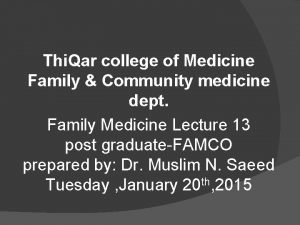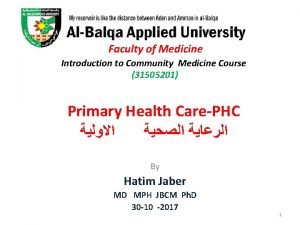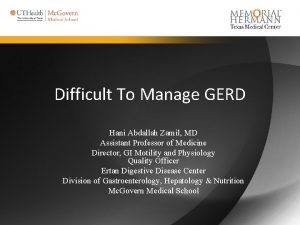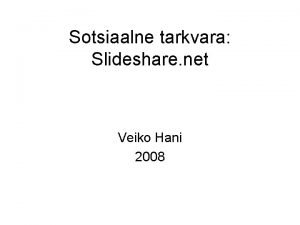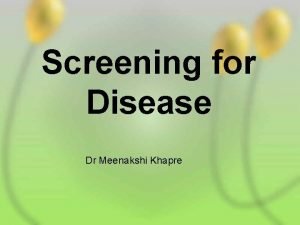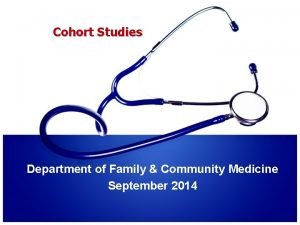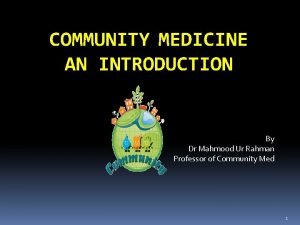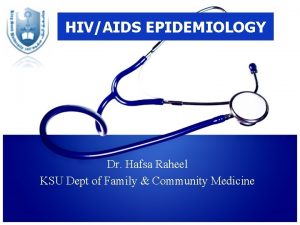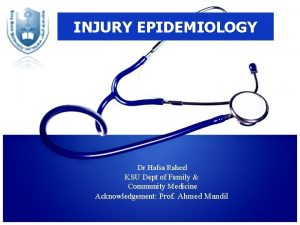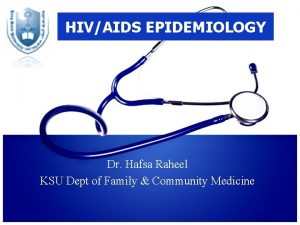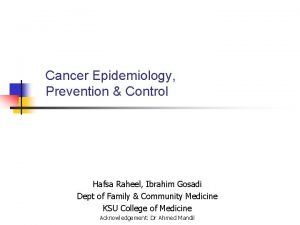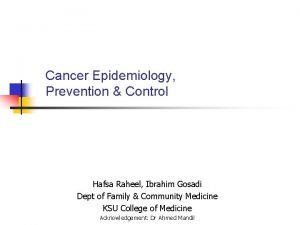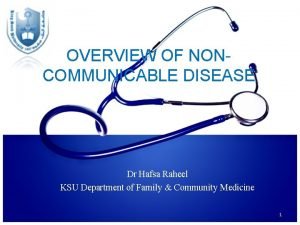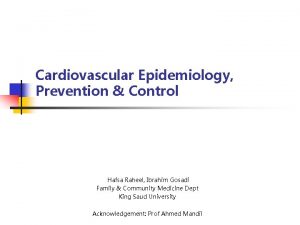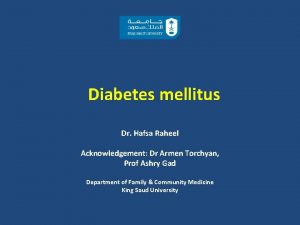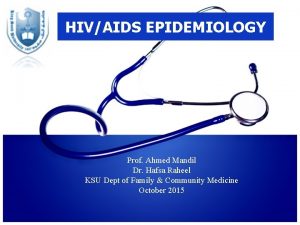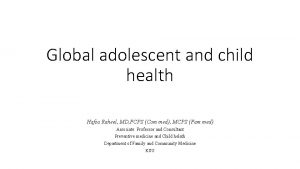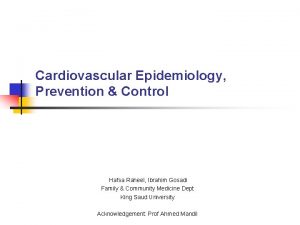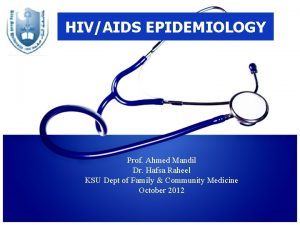Hafsa Raheel Hani Alghamdi Family Community Medicine Dept



































- Slides: 35

Hafsa Raheel, Hani Alghamdi Family & Community Medicine Dept King Saud University Acknowledgement: Prof Ahmed Mandil

By the end of the session students should be able to understand the: § Public health significance of CVD § Descriptive CVD Epidemiology § Analytical CVD Epidemiology § CVD Prevention and control (interventional epidemiology) CVD Epidemiology 13 January 2022 2

Cardiovascular disease (CVD) is the name for the group of disorders of heart and blood vessels, and include: § hypertension (high blood pressure) § coronary heart disease (heart attack) § cerebrovascular disease (stroke) § peripheral vascular disease § heart failure § rheumatic heart disease § congenital heart disease § cardiomyopathies. http: //www. who. int/cardiovascular_diseases/about_cvd/en/ CVD Epidemiology 13 January 2022 3

§ CVDs are the number one cause of death globally: more people die annually from CVDs than from any other cause. § An estimated 17. 3 million people died from CVDs in 2008, representing 30% of all global deaths. Of these deaths, an estimated 7. 3 million were due to coronary heart disease and 6. 2 million were due to stroke. § Low- and middle-income countries are disproportionally affected: over 80% of CVD deaths take place in low- and middle-income countries and occur almost equally in men and women. § Someone has a heart attack every two minutes (British Heart Foundation) § By 2030, almost 23. 6 million people will die from CVDs, mainly from heart disease and stroke. These are projected to remain the single leading causes of death. http: //www. who. int/cardiovascular_diseases/about_cvd/en/ http: //www. first-aid-safety. co. uk/blog/someone-has-a-heart-attack-in-the-uk-every-two-minutes CVD Epidemiology 13 January 2022 4

Significantly contributes to morbidity and death rates in the middle aged population: potential life years lost, common cause of premature death, labor force (economic costs) Nearly 30% of all disability cases A major impact on life expectancy Contributes to deterioration of the quality of life Leading cause of mortality in developed countries and a rising tendency in developing countries (disease of civilization) CVD Epidemiology 13 January 2022 5

§ Descriptive epidemiology: § Describing distribution of cardiovascular disease by PERSON (i. e. , age, gender, ethnicity) TIME and PLACE § Analytic epidemiology § Analyzing relationships between CVD and risk factors (which increase the probability of disease occurrence at population level), risk models, multicausal developments § Experimental epidemiology/Interventions § Strategies of CVD prevention (primordial, primary, secondary, tertiary; individual vs community levels) CVD Epidemiology 13 January 2022 6

Distribution Patterns in the World. AGE, SEX and ETHNICITY.

I. DISTRIBUTION PATTERNS IN THE WORLD § CVD deaths account for one third of all deaths (50% attributed to coronary deaths) § Developed countries: decreasing tendencies (e. g, USA, Sweden), attributed to: improvement of lifestyle factors, decrease of tobacco use, higher level of health consciousness, better diagnostic and therapeutic procedures § Developing countries: increasing tendencies (At least three quarters of the world's deaths from CVDs) due to: • • CVD Epidemiology Increasing longevity, urbanization, western type lifestyle Less or no integrated primary health care programs for early detection and treatment less access to effective and equitable health care services for patients who already had CVDs The poorest the more affected ? 13 January 2022 8

Source: http: //www. who. int/nmh/countries/sau_en. pdf? ua=1

1. AGE § Early lesions of blood vessel, atherosclerotic plaques: around 20 years - adult lifestyle patterns usually start in childhood and youth (tobacco use, dietary habits, sporting behavior, etc. ) § Increase in CVD morbidity and mortality: in age-group of 30 -44 years § Premature death (<64 years of age, or 25 -64 years): in the elderly population more difficult to interpret death rate due to multiple ill health causes CVD Epidemiology 13 January 2022 10

PROPORTION OF MORTALITY IN DIFFERENT AGE-GROUPS (MEN) 4, 7% 100% 14, 9% 90% 80% 70% 26, 0% 61, 5% 24, 6% external others cancer CVD 60% 50% 26, 9% 40% 30% 55, 8% 22, 5% 32, 7% 20% 11, 4% 10% 4, 6% 0% CVD Epidemiology 1 -24 yrs 25 -64 yrs >65 yrs 13 January 2022 11

PROPORTION OF MORTALITY IN DIFFERENT AGE-GROUPS (WOMEN) 100% 8, 2% 90% 4, 8% 18, 3% 40, 0% 24, 0% 80% 12, 2% 70% external others cancer CVD 60% 36, 5% 50% 35, 0% 40% 64, 7% 30% 20% 10% 0% 17, 7% 31, 3% 7, 3% CVD Epidemiology 1 -24 yrs 25 -64 yrs >65 yrs 13 January 2022 12

2. SEX § § § Widespread idea: CVD is often thought to be a disease of middle-aged MEN. Cardiovascular mortality (fatal cases) are more common among men. However, CVD affect nearly as many women as men, but at an older age Women: special case (WHO reports) § § § Higher risk in women than men (tobacco use, high triglyceride levels) Higher prevalence of certain risk factors in women (diabetes mellitus, depression) Gender-specific risk factors (risks for women only: use of oral contraceptives, hormone replacement therapy, polycystic ovary syndrome, etc) CVD Epidemiology 13 January 2022 13

3. ETHNICITY § In the US: increased CVD deaths among African-American and South-Asian populations in comparison with Whites § Increased stroke risk in African-American, some Hispanic American, Chinese, and Japanese populations § Migration: Japanese living in Japan had the lowest rates of CHD and cholesterol levels, those living in Hawaii had intermediate rates for both, those living in San Francisco had the highest rates for both (migrant studies) CVD Epidemiology 13 January 2022 14

Role of Risk Factors. Classification of Risk Factors: Hypertension Rheumatic Fever and Rheumatic Heart Disease Abnormal Blood Lipids Tobacco Use Physical Inactivity Unhealthy Diet, Obesity, Diabetes Psycho-social factors

I. ROLE OF RISK FACTORS § Over 300 risk factors have been associated with coronary heart disease, hypertension and stroke § About 75% of CVD can be attributed to conventional risk factors § Risk factors of great public health significance: § § High prevalence in many populations Great independent impact on CVD risk Their control and treatment result in reduced CVD risk Developing countries: double burden of risks (problems of undernutrition and infections in addition to CVD risks) CVD Epidemiology 13 January 2022 16

II. CLASSIFICATION OF RISK FACTORS Major modifiable risk factors - High blood pressure - Abnormal blood lipids - Tobacco use - Physical inactivity - Obesity - Unhealthy diet - Diabetes mellitus Other modifiable risk factors - Low socioeconomic status - Mental ill health (depression) - Psychosocial stress - Heavy alcohol use - Use of certain medication - Lipoprotein(a) Non-modifiable risk factors - Age - Heredity or family history - Gender - Ethnicity or race ”Novel” risk factors - Excess homocysteine in blood - Inflammatory markers (C-reactive protein) - Abnormal blood coagulation (elevated blood levels of fibrinogen) CVD Epidemiology 13 January 2022 17

1. HYPERTENSION Systolic blood pressure >140 Hgmm and/or a diastolic blood pressure > 90 Hgmm Free of clinical symptoms for many years (screening) In most countries, up to 30 percent of adults suffer from hypertension Positive family history Dietary habits (a high intake of salt, processed food, low levels of water hardness, high thyramine content of food, alcohol use) Modern lifestyle (increased sympathetic activity, psychosocial and occupational stressors) CVD Epidemiology 13 January 2022 18

2. RHEUMATIC FEVER AND RHEUMATIC HEART DISEASE Development: Rheumatic fever usually follows an untreated beta-haemolytic streptococcal (GABS) throat infection in children As a consequence, some heart valves (e. g. mitral, tricuspid) may be permanently damaged, which may progress to heart failure Today mostly affects children in developing countries, linked to poverty, inadequacy of health care access Occurrence: 12 million people are currently estimated to suffer from rheumatic fever and RHD, of whom twothirds are children (5 -15 years) CVD Epidemiology 13 January 2022 19

3. ABNORMAL BLOOD LIPIDS Serum cholesterol: structure and functioning of blood vessels, atherosclerotic plaques Altering functions of cholesterol fractions (LDL: risk, HDL: protection) Estrogen: tends to raise HDL-cholesterol and lower LDL- cholesterol, which provides protection for women during their reproductive age (15 -49 years) Partially genetic determination of metabolism, partially dependent of nutrition (eggs, meats, dairy products) CVD Epidemiology 13 January 2022 20

CVD Epidemiology 13 January 2022 21

4. TOBACCO USE The link between smoking and CVD (mainly CHD) was identified in 1940 Greatest risk: initiation during adolescence (< 16 years) Passive smoking: additional risk Women smokers: are at higher risk of CHD and CVD than male smokers Several mechanisms: damages the endothelium lining, increases atherosclerotic plaques, raises LDL and lowers HDL, promotes artery spasms, raises oxygen demand of cardiac muscles Nicotine accelerates the heart rate and raises blood pressure CVD Epidemiology 13 January 2022 22

5. PHYSICAL INACTIVITY Regular physical activity: protective factor Physical activity: helps reduce stress, anxiety and depression Intensity and duration (150 minutes/week or 60 minutes/day) Modernization, urbanization, mechanized transport: sedentary lifestyle (60% of global population) Raises CVD risk and also the development of other risk factors (glucose metabolism, diabetes mellitus, blood coagulation, obesity, high blood pressure, worsening lipid profile) CVD Epidemiology 13 January 2022 23

6. UNHEALTHY DIET, OBESITY, DIABETES Unhealthy diet: low fruits, vegetables, fiber content; high saturated fat intake, refined sugar Body Mass Index (BMI): > 25: overweight; > 30: obesity A modern ”epidemic”: more than 60% of adults in the US are overweight or obese, in China: 70 million overweight people Increases the risk of both CVD and diabetes mellitus Diabetes mellitus: damages both peripheral and coronary blood vessels (micro-angiopathies) CVD Epidemiology 13 January 2022 24

7. PSYCHO-SOCIAL FACTORS Psychological factors (Type A behavior, hostility) Depression and CVD: bidirectional link depression may increase the risk of CVD and worsen recovery process CVD may induce depression Low socioeconomic status (SES): In developed countries: less educated and lower SES groups (accumulation of risk factors) In developing countries: more educated and higher SES groups (western lifestyle) CVD Epidemiology 13 January 2022 25


Primordial: social, legal and other (often nonmedical) activities which may lead to lowering of risk factors (e. g. socioeconomic development, smoke-free public places) Primary: controlling risk factors contributing to CVD (health education programs, tobacco prevention campaigns, sports programs, nutrition counselling, regular check-up of blood pressure / certain blood parameters, e. g. blood lipids including cholesterol, glucose, etc) CVD Epidemiology 13 January 2022 27

Secondary: early detection by screening / setting up personal risk profile; proper management of symptomatic patients Tertiary: CVD rehabilitation (e. g. for stroke, paralysis patients); prevention of CVD recurrence (CVD patients have a 5 -7 times higher risk of a new heart attack) CVD Epidemiology 13 January 2022 28

§ Non-modifiable risk factors (e. g. age, sex, race, and family history of CVD) identify high -risk populations § Behavioral (modifiable) risk factors (e. g. sedentary lifestyle, unhealthy diet, tobacco or alcohol use, physical inactivity) § Physiological risk factors (e. g. hypertension, obesity, lipid problems, and diabetes) may be a consequence of behavioral risk factors CVD Epidemiology 13 January 2022 29

The population-wide approach: targeting the whole population: includes tobacco prevention programs, salt and refined sugar restriction, promoting high fiber – low fat diets, etc. The individual approach: detecting those at greatest risk: includes targeting lifestyle guidelines, e. g. tobacco cessation programs CVD Epidemiology 13 January 2022 30

Examples of community-wide CVD prevention programs: Framingham Heart Study & Risk Scoring (1948 -), USA North-Karelia Project (1972 -), Finland Stanford Projects (1972 -75, 1980 -86), USA Multiple Risk factor Intervention Trial (1972 -79), USA Minnesota Cardiovascular Health Program (1980 - 88), USA CVD Epidemiology 13 January 2022 31

CVD Epidemiology 13 January 2022 32

CVD Epidemiology 13 January 2022 33

CVD Epidemiology 13 January 2022 34

§ Newschaffer CJ, Longjian L, Sim L. Cardiovascular disease. In: Remington PL, Brownson RC, Wegner MV. Chronic disease epidemiology and control. 3 rd edition. Washington DC: American Public Health Association, 2010. § Piko B. Epidemiology of cardiovascular diseases. University of Pittsburgh. § Expert Panel on Detection, Evaluation, and Treatment of High Blood Cholesterol in Adults. JAMA. 2001; 285: 2486 -2497. § Werner et al. Canadian Journal of Cardiology 1998; 14(Suppl) B: 3 B-10 B CVD Epidemiology 13 January 2022 35
 Hafsa riaz
Hafsa riaz Doç dr hafsa kesgin
Doç dr hafsa kesgin Raheel choudhary
Raheel choudhary Raheel choudhary
Raheel choudhary Alya alghamdi
Alya alghamdi Types of family in community medicine
Types of family in community medicine Elements of primary health care
Elements of primary health care Duke medicine grand rounds
Duke medicine grand rounds üks hani neli nina
üks hani neli nina Jerome and hani get up early
Jerome and hani get up early Dr hani zamil
Dr hani zamil Radpeer acr
Radpeer acr Abeer saif age
Abeer saif age Hani rabbin meleklere
Hani rabbin meleklere Veiko hani
Veiko hani Sidi el hani
Sidi el hani Lead time in community medicine
Lead time in community medicine Lead time in community medicine
Lead time in community medicine 10 importance of health education
10 importance of health education Introduction to community medicine
Introduction to community medicine Introduction to community medicine
Introduction to community medicine Cohort study community medicine
Cohort study community medicine Seqs community medicine
Seqs community medicine Dept nmr spectroscopy
Dept nmr spectroscopy Fl dept of agriculture
Fl dept of agriculture Finance department organizational chart
Finance department organizational chart Worcester ma building department
Worcester ma building department Dept. name of organization
Dept. name of organization Mn dept of education
Mn dept of education Department of finance and administration
Department of finance and administration Dept. name of organization (of affiliation)
Dept. name of organization (of affiliation) Ohio dept of dd
Ohio dept of dd Dept. name of organization (of affiliation)
Dept. name of organization (of affiliation) Vaginal dept
Vaginal dept Gome dept
Gome dept Gome dept
Gome dept





